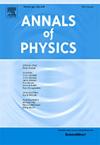The ground states of spin–orbit coupled Bose–Einstein condensates in spin-dependent potential
IF 3
3区 物理与天体物理
Q2 PHYSICS, MULTIDISCIPLINARY
引用次数: 0
Abstract
By exploring the Rashba spin–orbit (SO)-coupled pseudo-spin-1/2 Bose–Einstein condensates (BECs) with the Gross–Pitaevskii equations, we investigate the ground state properties of condensates in spin-dependent Gaussian potential. The condensates exhibit many rich density patterns due to competition among interparticle interaction, SO coupling and trapping potential. In the regime of fixed potential well spacing, with relatively weak SO coupling strength, a novel structure called skyrmion dipole can be observed. And the transition between skyrmion dipole, plane wave (PW) phase with vortex array, and stripe phase can be realized by changing the SO coupling strength. In the regime of fixed SO coupling strength, the non-overlap of two potential wells breaks the rotational symmetry of the potential well, and the spatial orientation of the stripe state and the PW state to be locked in a specific direction while each component replicates the same structure in the potential well of the other component. The orientation of the plane waves and stripes in both structures is same for small well spacing and independent for large well spacing. This work enriches the ground state phases of the ultracold atomic systems and deepens our understanding of topological excitation in cold atom physics and condensed matter physics.
自旋轨道耦合玻色-爱因斯坦凝聚在自旋相关势中的基态
利用Gross-Pitaevskii方程对Rashba自旋-轨道(SO)耦合的伪自旋-1/2玻色-爱因斯坦凝聚体(BECs)进行了研究,研究了自旋相关高斯势下凝聚体的基态性质。由于粒子间相互作用、SO耦合和俘获势的竞争,凝析油呈现出丰富的密度模式。在固定电位井距下,在相对较弱的SO耦合强度下,可以观察到一种称为skyrmion偶极子的新结构。通过改变SO耦合强度,可以实现skyrmion偶极子、涡旋阵列平面波相和条纹相之间的转换。在固定SO耦合强度下,两个势阱的不重叠破坏了势阱的旋转对称性,条纹态和PW态的空间取向被锁定在特定方向上,而每个分量在另一个分量的势阱中复制相同的结构。两种结构的平面波和条纹方向在小井距下是相同的,在大井距下是独立的。这项工作丰富了超冷原子系统的基态相,加深了我们对冷原子物理和凝聚态物理中拓扑激发的理解。
本文章由计算机程序翻译,如有差异,请以英文原文为准。
求助全文
约1分钟内获得全文
求助全文
来源期刊

Annals of Physics
物理-物理:综合
CiteScore
5.30
自引率
3.30%
发文量
211
审稿时长
47 days
期刊介绍:
Annals of Physics presents original work in all areas of basic theoretic physics research. Ideas are developed and fully explored, and thorough treatment is given to first principles and ultimate applications. Annals of Physics emphasizes clarity and intelligibility in the articles it publishes, thus making them as accessible as possible. Readers familiar with recent developments in the field are provided with sufficient detail and background to follow the arguments and understand their significance.
The Editors of the journal cover all fields of theoretical physics. Articles published in the journal are typically longer than 20 pages.
 求助内容:
求助内容: 应助结果提醒方式:
应助结果提醒方式:


